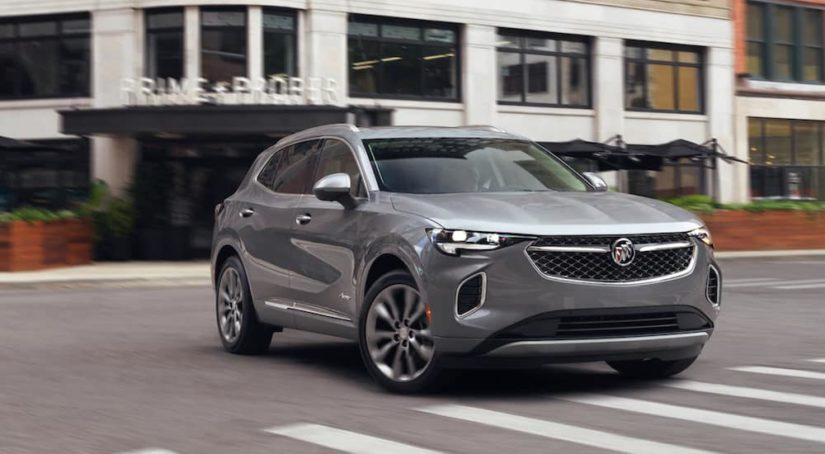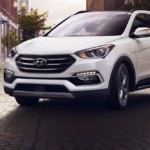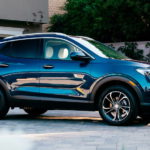The compact SUV segment is overflowing these days, and it can be hard to know what to look for, especially when each automaker offers basically the same thing as their competitor, dressed up with a different name. How is GM’s Positraction system different from Ford TrueTrack? Well, the name, really. Both are limited-slip differentials and do pretty much the same thing. The world of marketing can be a strange beast to navigate, especially if all that a consumer is looking for is a place to start. In this article, we’ll be taking two popular compact SUVs and will be putting them head to head in the areas of styling and performance. This is the 2021 Buick Envision vs 2021 Hyundai Santa Fe.
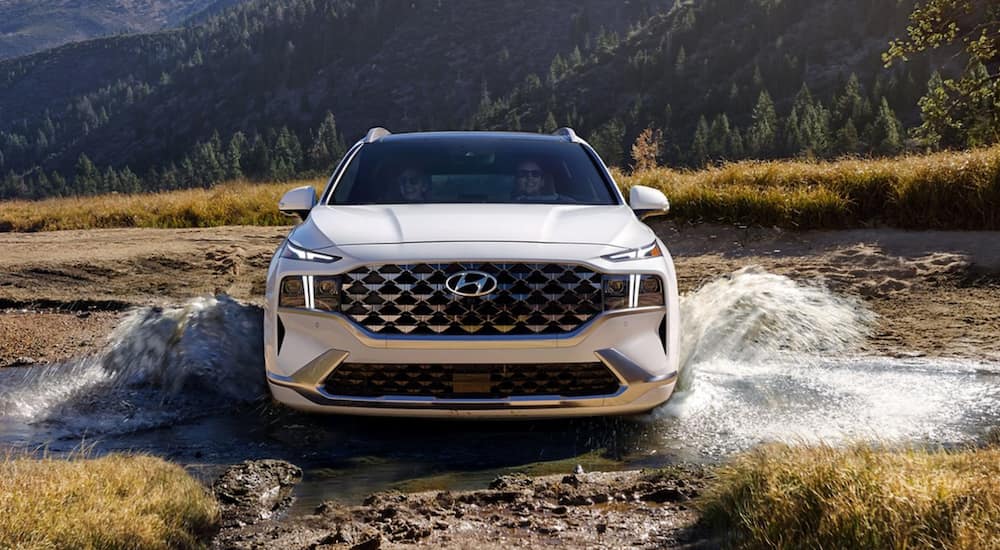
Styling: Busy isn’t Always Better
Beauty is in the eye of the beholder, as we are all aware. In a field so overcrowded with options, automakers have to do anything to stand out. Unfortunately, that can lead to some… questionable… design choices. Take the front end of the Santa Fe, for example. The grille is absolutely massive, and while that’s not uncommon in today’s luxury car field, the material Hyundai has used to fill in this area makes the front end look like it has sprouted a huge toothy maw. The material is so spread out with its triangles upon triangles theme that one can look straight through it and see the radiator, a detail most automakers try to hide.
Also, the trend of having the headlights embedded below the traditional spot on the fenders can be rather dashing, but the SantaFe is not a good example of this. The combination of turn signal and running lights that sit at the tops of the fenders are so thin that they look as if the car is squinting to see something far off in the distance. Modern LEDs have allowed designers to get away from old headlight styling, but Hyundai’s team might want to dial things back a bit.
The Buick front end is much more conventional, with both headlights and turn signals in one sleek unit. The grille is large but is filled in using an attractive black mesh with silver bars meeting supporting the iconic Buick triple-shield. The understated shape is all Buick and gives the whole car a quiet yet undeniable presence.
The same overly busy design can be said of the Santa Fe’s wheels that can be said of the front end. What could’ve been a perfectly serviceable star design is turned into a mess of seemingly conflicting angles meeting in the middle of the wheel. The wheels offered on the Envision are a simple style that does not distract from the rest of the design.
Moving around to the rear of each car, you’ll find the styling is very similar. Both feature a large hatch flanked by highly visible tail lights. However, it seems those lights will be put to little use in the Santa Fe by virtue of the fact that the turn signals are found nowhere in them. For some strange reason, the turn signals are housed low, in the bumper where they may be hard to see. The Envision has its turn signals in the tail light clusters where they can be easily seen by all.
The interior is more of the same from the Sante Fe. The center console arches up from the middle of the seats to meet the dashboard, which is a very common styling feature among cars of its class. It has a very large 10.25-inch infotainment screen which, while impressive at first blush, may leave one wondering what exactly it is able to do because the area surrounding the shifter buttons is itself surrounded by buttons. They lay splattered all over the panel, thirty-three in all, NOT including the large drive mode knob or four shifter buttons!
The Envision’s cabin has buttons in the same area as the Santa Fe, that’s true. It has six in a neat row that act as shortcuts for the touchscreen. They sit above the gear selector buttons, also numbering just six, including the electronic parking brake. It may seem odd to break this down number by number, but it just goes to show you how much easier the Envision is to navigate for simple controls. The 10.2-inch touchscreen in the Envision is a hair smaller than the Santa Fe, but it is canted slightly towards the driver to eliminate glare on sunny days.
All these might seem like small details. You might not notice them on the test drive, you might not notice them a week or two into owning the Santa Fe, but it’s these small things that might begin to weigh on you as you drive day in, day out. Something you might have wished you had considered when you had the chance.
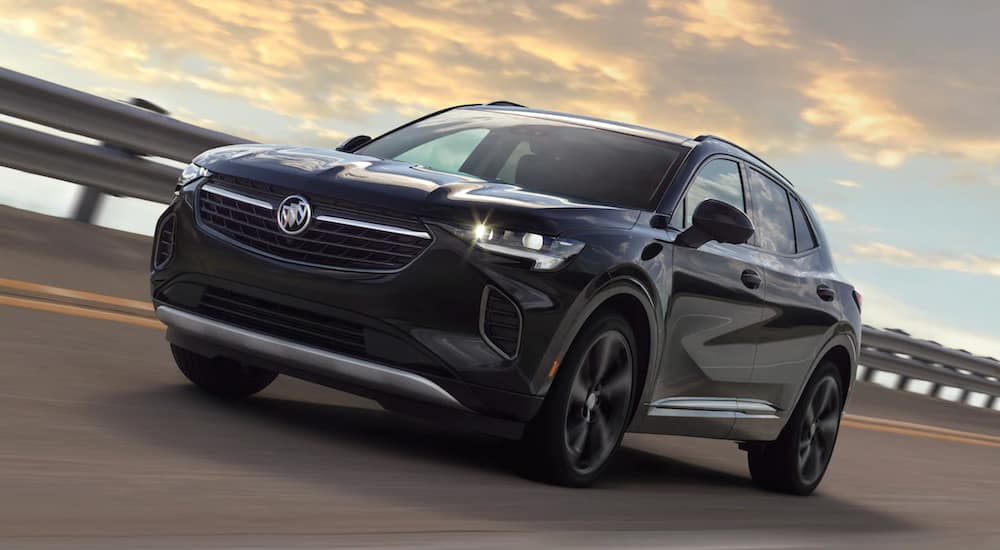
Performance: No Compromise
The Santa Fe offers two choices of engine: a 2.5-liter naturally aspirated four cylinders and a 2.5-liter turbocharged four-cylinder. In contrast, the Buick Envision offers just one engine, a 2.0-liter turbocharged four-cylinder. While the Santa Fe may seem like a better choice because of this, it warrants a closer look.
The base engine offered in the Santa Fe, the 2.5-liter without the turbo, makes only 191 horsepower. If you want more get up and go from your base model Santa Fe, you simply won’t find it, not without opting for the turbo model, that is. In the Envision, you get a turbo for no extra cost that provides you with a solid 228 horsepower. The Buick Envision will have power to spare, no matter where you are or what you bring along with you. The Santa Fe also uses an eight-speed automatic transmission, where the Envision uses a nine-speed gearbox.
The combination of a standard turbocharger and an extra gear ratio means that despite offering significantly more power than the base Hyundai SUV, the Buick model gets virtually identical gas mileage. Both models are rated at 26 MPG combined when configured with front-wheel drive. When all-wheel drive is considered, the Envision actually pulls ahead at 25 MPG combined against 24 MPG combined for the Santa Fe.
Now, the Santa Fe does offer a more powerful 2.5-liter turbocharged engine with 281 horsepower. But that extra power comes at a price, with the worst fuel economy of the three engines. The top Hyundai engine is also paired with a dual-clutch transmission, which is all well and good, except most dual-clutch transmissions are known to be choppy at low speeds. They were originally meant to be driven quickly, and there are not many compact family SUVs that belong on a racetrack where the dual-clutch transmission is at home.
Keeping It Simple
The Buick Envision is elegant in a way that Buick has always been known for. The looks are understated with an impactful presence. The interior includes the little touches one doesn’t necessarily look for in the test drive but will certainly be thankful for when the honeymoon period wears off. The engine and transmission combination is powerful and uncomplicated, perfectly balancing efficiency and ride quality. While there are many premium SUV options on the market today, the redesigned 2021 Buick Envision deserves your attention.
